Countability and uncountability
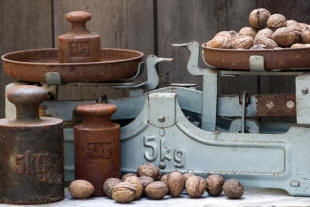
If you have done the guide to word class, you'll know that nouns can
be countable (table, dog etc.) or uncountable (water, love,
sugar, anger
etc.). You'll also know that some can be both (the seven seas,
two sugars, the loves of her life).
Here we look a bit harder at this very important distinction.
In the picture above, therefore, we can talk about an uncountable noun (weight)
and a countable one (kilo[s]). Note, too, that we can
have weights but in a different meaning.
This is not only a very important distinction, it is one that not all
languages share and which causes really serious problems for learners at
all levels.
In English, it is almost impossible to use a noun correctly unless one
first decides whether the noun is to be used as a count noun or as a
mass noun.
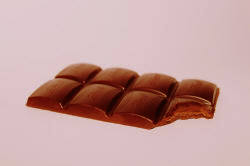 |
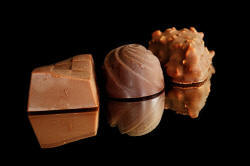 |
Mass and Count nouns |
| some chocolate | some chocolates |
The usual distinction made in classrooms is between countability and uncountability and that's probably enough for most learners. However, we teachers need to know a bit more about the area so a better categorisation is between mass nouns and count nouns. Often, the term uncountable noun is wrongly used for count nouns which are only plural but obviously countable. We can say three people or six cattle and this means that the nouns are count nouns but plurals (albeit slightly odd plurals). Both people and cattle are count nouns but they only occur in the plural.
While the terms countable and uncountable nouns are helpful for some purposes, they are misleading.
For example, money is a
mass noun we can count. We cannot say
*How many money?
but have to choose
How much money?
Almost all mass nouns can be made count
nouns by the use of another noun so we can have
some cake → a slice of cake
some cheese → a bit of
cheese
lots of a information → two pieces of information
too much sugar → three kilos of sugar
etc. What we do here is add a measure (pint,
yard, kilo etc.) or a partitive (bit, piece,
lump, slice, chunk etc.)
By the same token, it is arguably advisable to tell our learners
about count and mass uses rather than count and
mass nouns because that's nearer the truth of the matter. For
example, we can have:
How much cheese is in the fridge?
and
How many cheeses are in the fridge?
The rough sea is coming over the harbour.
and
The rough seas are coming over the harbour.
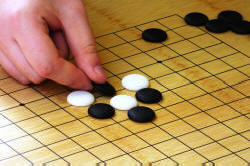 |
Count nouns |
This is the simplest category but it's not always obvious from the form whether a noun is a count noun or not. The usual defining characteristic of a count noun is its ability to form a plural (usually with -s) when it demands a plural verb form. Secondarily, is the fact that one can use the indefinite article (a[n]) before it. There are some important exceptions and irregular forms to consider.
count nouns which only appear in the plural
- cattle, people, police, vermin etc.
But there are corresponding nouns which can be used in the ordinary, count way: cow, person, police officer, rat. - objects containing two equal parts, e.g.:
trousers, tongs, scissors, glasses etc.
are either never found in the singular or have a different meaning in that form. For example:
A: Where's my glass?
B: It's in front of you. Put your glasses on! - Some count nouns have no singular form. For example:
annals, arrears, earnings, outskirts, valuables, savings etc.
You can put a determiner such as few, many etc. before these but not a number (many valuables, *six valuables) - Count nouns may have a plural-only form but a singular or mass
form which has a different meaning. For example:
arms (weaponry, countable only plural) vs. arm (limb, countable)
grounds (reason, countable only plural) vs. ground (surface of the earth, mass noun)
damages (money awarded for by a court, countable only plural) vs. damage (harm, mass noun)
irregular plurals
There are quite a number of common irregular plurals (mostly the result of retaining older forms) and some other oddities to know about:
- old plural forms: louse / lice, mouse / mice, ox / oxen, man / men, foot / feet, tooth / teeth etc. These are well known and can be taught as they occur. There's no rule.
- zero plurals: sheep, deer, grouse, dozen (when it's
exact, dozens when it means lots). The names
of many different animals (especially fish) work this way. We
can have:
five dozen people came vs. dozens arrived
one sheep vs. sixteen sheep
some fish for tea vs. three fish in the pond [but fishes is also possible in this sense] - the f vs. v problem: plurals such as
roofs, dwarfs, handkerchiefs
are common but the regular form (and increasingly the regular pronunciation) is to change the f to a v in the plural and add -es:
wolves, halves, ?rooves - the -os vs. -oes problem: the regular plural of nouns ending in -o is to add -s (radios, kilos etc.) but there are a number which add -es (potato, tomato) and some which can do both (mosquito).
- foreign plurals: sometimes English retains the
plural form of the language from which the noun has come:
phenomenon / phenomena, antenna / antennae, larva / larvae, crisis / crises
sometimes we can choose either the foreign or English plural (syllabuses or syllabi) and sometimes the word is pluralised in one use (index / indices in scientific writing but indexes in non-scientific use) - plurals made singular: graffiti, data and media are all plurals often treated as singular in English. The use of criteria instead of criterion as a singular is just wrong.
nouns modifying other nouns
Many count nouns can work to modify other nouns, by a process called
compounding or by classifying the noun in some way, e.g.:
a book
sale, a pencil case, a saloon car, a windmill
In this use the singular is used for the first noun unless there's
a possibility of ambiguity. So we get
a book shop, a two-hour shift, a four-year-old child, boy scouts,
child actor etc.
but not:
*three booksshops, *a four-years-old child etc.
There are some exceptions: men friends, women doctors and some
avoiding ambiguity such as arms race.
Notice here, too, that some nouns which are nearly always plural only
appear in the singular when modifying other nouns:
spectacle case,
binocular case, trouser pocket.
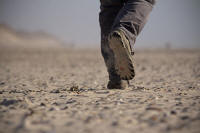 |
Unmarked uses of count nouns |
| on foot |
There are times when the amount of a count noun really doesn't matter – it's the concept we want to express so we treat the nouns as mass nouns and leave out the article. We get, therefore, example such as:
go to / be in bed, church,
school, hospital etc.
travel by / go by car, bicycle,
plane, rail ferry etc.
at / before / after / by / in
dawn, sunset, sunrise, autumn, day, night etc.
Many reference books treat these kinds of thing as idioms to be learned separately but it is conceptually easier to see them as unmarked forms (Chalker 1987: 29).
There are a number of other expressions in which the noun is not marked for plural or singular forms. Here's a list (also based on Chalker, op cit.):
- Other prepositional phrases:
by chance, on call, by hand, in mind, at heart
etc. - Parallel structures:
arm in arm, eye to eye, year after year
etc. - Double structures:
hand over fist, life after death, hand on heart
etc.
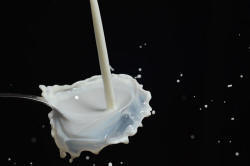 |
Mass nouns |
It's easy enough to spot normal mass nouns because
- you can't put the indefinite article in front of them (*a milk, *a money, *a bread etc.)
- they normally have no plural form (*milks, *furnitures, *informations etc.)
So we get the common list of mass nouns:
advice, anger, assistance, bread, chaos, courage, dirt, education, information, leisure, luck, machinery, milk, news, permission, poetry, rubbish, shopping, transport, weather etc.
These are mass nouns in English but
not in many languages.
Many abstract nouns in English are mass nouns.
But:
nouns with both mass and count uses
- These sometimes have subtle distinctions but the meaning is
close. Examples are:
Unemployment is affecting business vs. Businesses are closing
Noise is a problem here vs. The noises can be disturbing
Chocolate is addictive vs. These chocolates are delicious - Sometimes the distinctions are much greater in meaning.
For example:
Dress is formal vs. She's wearing a formal dress
It's made of iron vs. Most people have electric irons
The works of Shakespeare vs. Finding work is difficult
(Sex is another of these nouns, by the way.) - Occasionally, English users like to omit what are often called
unit nouns. Unit nouns (better known as partitives) are the items we use to express a
quantity of a mass noun. So we have, e.g.:
a blade of grass
a pint of beer
a bit of cotton
a piece of furniture
a teaspoon of sugar
a cup of coffee
etc.
Sometimes, the unit noun is omitted to allow two sugars, three beers, a few coffees etc. This is not particularly common and can't occur with most mass nouns. It's also informal. - Almost all mass nouns can be used as count nouns when we are classifying: Spanish wines, Greek cheeses, spicy foods etc. but some remain resiliently mass nouns (furniture, information, music, for example).
| Related guides | |
| partitives and classifiers | for a more advanced guide how mass nouns may be made countable |
| word class | for an overview |
| nouns | for a more advanced guide to nouns in general |
References:
Chalker, S, 1987, Current English Grammar, London:
Macmillan
